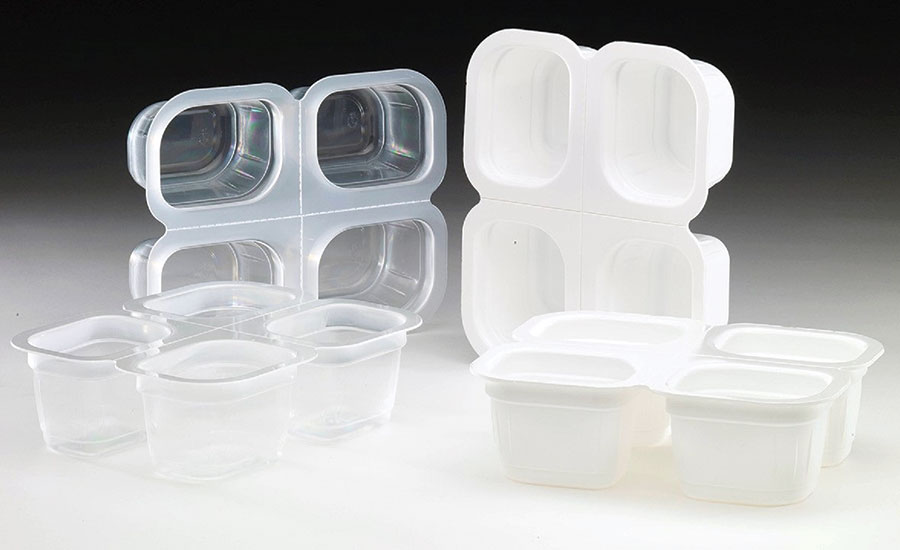Materials Technology: Rigid Packaging
Pack to the Future with Rigid Packaging
Rigid plastic containers are making a comeback—and should continue to do so in the foreseeable future.












Lighter weight, higher performance and more cost-effective than traditional metal or glass packaging, rigid plastic is seeing innovations that challenge its rivals. Add to that the increasing use of bioplastics, reusable plastics and improved barrier properties, and rigid plastic containers definitely have a solid role in packaging.
According to the report “The Future of Rigid Plastic Packaging to 2022” by Smithers Pira (smitherspira.com), global rigid plastic packaging consumption will exceed $200 billion at the end of the forecast period in 2022. Volume consumption globally is projected to grow over the next five years at an annual rate of 3.7 percent to 63.4 million metric tonnes.
The plastic can
Developed by Milacron (milacron.com), Klear Can technology aims to transform canned foods, saving weight and allowing a better display of the goods on supermarket shelves. Milacron partnered with S&W Fine Foods International, a Del Monte Pacific Ltd. company, hitting shelves in Asia with their pineapple chunks and slices packaged in the Milacron Klear Can.
After successful qualitative testing with consumers in Asia conducted by Nielsen Market Research (nielsen.com), S&W Fine Foods International chose the Klear Can for its products to highlight the product quality and freshness by allowing consumers to see through the packaging. The Klear Can is an alternative to metal cans for a variety of products. The can’s unique transparency shows the quality of the product on shelf—where consumers make their purchase decisions.
The Milacron Klear Can is co-injection molded, polypropylene EVOH, which can be cooked and seamed meeting all industry standards. It is BPA-free for safe food contact, recyclable and microwavable. It is designed to withstand standard retort pressures and temperatures (up to 130˚C). Klear Can uses a standard metal can end, and uses the industry standard can end double-seam process. The Milacron Klear Can also can be used with in-mold labels (IML).
More sustainability, please
With the growing importance of sustainability to consumers, this is by far the No. 1 challenge for this packaging material type. The Smithers Pira report says users should concentrate on three areas of sustainability:
- Light-weighting
- Increased use of recycled plastic feedstocks
- Investigating the use of bioplastic packaging
Many brands have already jumped on the sustainable bandwagon for their rigid plastic packaging. Consider Unilever, whose Sustainable Living Brand grew 50 percent faster than the rest of its product portfolio,with many of the products packaged in rigid plastics.
Another, Procter & Gamble, teamed with recycling company TerraCycle on its new Fairy Ocean Plastic bottle. Made completely from post-consumer recycled (PCR) plastic and ocean plastic, the launch aims to raise awareness of the issue of what can be done to prevent plastic waste from reaching the ocean.
The U.K. launch in 2018 will include 320,000 bottles, the largest production run of recyclable dish soap bottles in the world made using ocean plastic. The innovative bottle will be made from 10% ocean plastic, collected from the ocean and beaches around the world, and 90% post-consumer recycled plastic.
What Consumers Want
Heavy on a consumer’s mind? Reusable, stackable, recyclable… all of it. Throw in the fact that one of the following comes right to your door, and you have a winner.
StackTek (stacktek.com) has partnered with Yumi, a fresh meal delivery service for infants and toddlers. The partnership marks StackTek’s expansion beyond the wine category, an industry they’ve disrupted in 2011 with their recyclable, shatterproof PET containers that enable brands to offer portability and convenience.
StackTek’s patented technology allows Yumi to deliver their organic purees and signature blends in single-serve portions, each individually sealed in BPA-free, reusable containers. StackTek Co-Founder, Jodi Ryan, recognized how well suited their cutting-edge packaging was for Yumi’s fresh, ready-to-eat meals for tots, which often consist of exotic super foods such as Japanese sweet potato and dragon fruit. “Yumi is an ingenious solution for parents who want convenience without compromising on quality, a key objective that was also behind the design inspiration of StackTek,” says Ryan.
StackTek containers are engineered to snap together to form a stack, and are a premium and portable alternative to traditional, glass bottles. With high-grade PET and barrier-enhancing technology that protects the quality of its contents, it was a natural transition for StackTek to extend beyond the beverage category and into food.
With continuing high demand for convenience packaging solutions, RPC Bebo UK (rpc-bebo.com) has launched a selection of new packs in both polypropylene (PP) and PET suitable for a wide variety of products. The 60mm diameter PP pot—available in 45ml, 60ml and 75ml sizes—is ideal for dips, salads, fruit pieces and snack meals. The four compartment Snap PP tray, with a 220ml brimful capacity per cavity, offers a convenient multi-pack solution for both food and non-food applications. All four compartments can be easily separated for individual servings or to stack in a cupboard.
Both packs can be specified in a choice of materials: monolayer PP or ultra-high clarity PPure, and barrier PP/EVOH/PP for long ambient shelf-life products. They are suitable for direct food contact, hot filling and high temperature processes such as sterilization and pasteurization. Special grades are available for microwave cooking and reheating.
The EZ Scoop by TricorBraun (tricorbraun.com) makes digging into any container, well, easy—not only for the end user, but for the brand owner. The ergonomic design offers simple hand gripping, as well as easy access due to EZ Scoop’s handle that allows it to be stored in the neck of the bottle/container. This not only eliminates the risk of the scoop falling out but because it can be stored in any direction, the EZ Scoop is easy to remove and replace.
The EZ Scoop can be inserted into the neck ring of a bottle at any radius within 360 degrees and when tested, assembly line speeds were not compromised. The accessibility allows production line workers easy access in the packaging process. The scoop also prevents contamination, without having to dig into powdered products to find the scoop.
Pretium Packaging (pretiumpkg.com) has developed a 64-oz, 38-400 mm finish, stock monolayer PET container with an integrated handle. With technology from Practically Impossible Labs, the SureHandle PET container gives brand owners significant shelf differentiation, handling convenience and aesthetics that were not previously possible. The container is easy to handle for both younger children and older adults, and those with physical challenges, appealing to a wider audience.
SureHandle not only provides carrying advantages, but also improved pouring control. It has been engineered for products needing fill temperatures up to 120˚F and can accommodate an induction seal or foam liner. Additionally, the container has been designed with enhanced top load capabilities. This enables the use of a shrink wrapped tray pack (vs. a corrugated case) which can withstand stacking of five layers to a pallet, four pallets high. Using a tray pack can potentially reduce secondary packaging costs by up to 80 percent. Consider the SureHandle container for beverages, dressings and sauces, and liquid cleaners and detergents.
The Smithers Pira report reveals that food is the largest end-use market for rigid plastic packaging, accounting for a projected 37.0% consumption share in 2017. The healthcare sector is forecast to grow at the highest rate, followed by other food markets, drinks and cosmetics. That’s a lot of work as long as the technology can keep up.
Though still fighting against its flexible counterpart, rigid plastic packaging has enough points stacked in its corner to weather the challenges it faces. Many products still stand tall in rigid containers, and the packagers and manufacturers who create them must keep pushing technology forward. With on-the-go convenience packaging growing and the need for compartmentalized containers (such as yogurt in a cup with toppings in a separate compartment), rigid plastics still have a hand in the game.
Looking for a reprint of this article?
From high-res PDFs to custom plaques, order your copy today!













